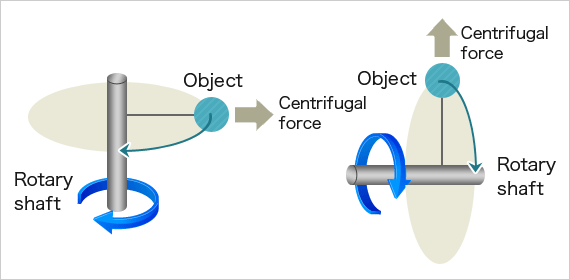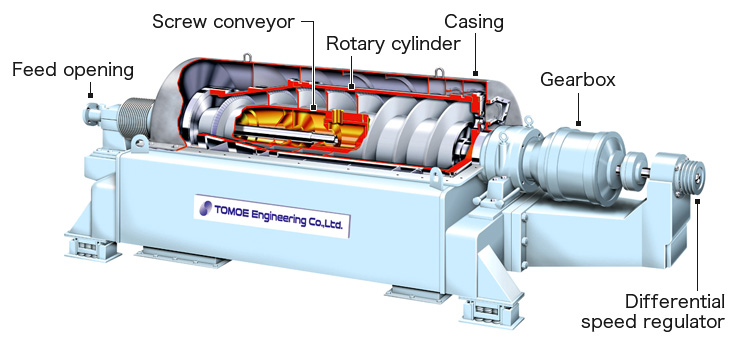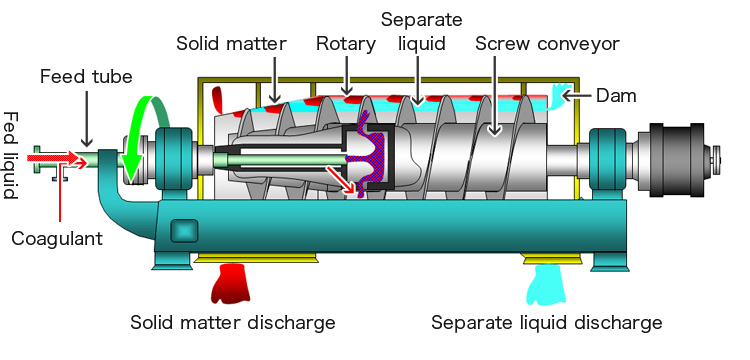Mechanism of centrifugal separator
What is a centrifugal separator?
Centrifugal separation means separating substances of different specific gravity levels by means of centrifugal force.
Like water and oil, substances separate through natural sedimentation if they have different specific gravities. The substance with the heavier specific gravity takes time to sediment because the sedimentation takes place under gravity of only 1 G. However, this substance can be sedimented and separated in a short time by rotating it and performing centrifugal sedimentation with centrifugal force.
Natural sedimentation

Substances are sedimented under a gravity of only 1 G, and solid matter with heavy specific gravity takes time to sediment.
Centrifugal sedimentation

Rotating the stock solution produces centrifugal force, which helps the substances sediment in a shorter time than natural sedimentation.
Separate the sedimented substance.
Substances are separated even in natural sedimentation if there is a difference in specific gravity between them.

| Name | Specific gravity | |
|---|---|---|
| Mother liquor | Water, solvent, etc. |
1 0.7~1.2 |
| Sediment | Solid matter | 0.8~7 |
Decanter type centrifugal separators (which are Tomoe Engineering's main products) are designed to forcibly perform centrifugal-sediment separation, and take out the target substances with centrifugal force that is several thousands to tens of thousands times higher than gravity. Because of their ability to separate an extremely large volume of substances quickly and continuously, decanter type centrifugal separators are used for a wide variety of applications, such as:
- Food (surimi, juices, seasonings, extracts)
- Chemistry (high-purity terephthalic acid, polyvinyl chloride, polypropylene, polyethylene)
- Environmental conservation (sewage, night soil), pharmaceuticals (antibiotics, medical fungus bodies)
- Energy (fuel oil, dehydrated plaster), recycling (industrial wastewater, waste plastics)
- Other (coal, tar, muddy water, abrasive, PCB, etc.)
Centrifugal force
The centrifugal force working on an object is determined by the distance from the center of rotation to the object (radius of rotation) and the rotating speed. Centrifugal force

Centrifugal effect ≒ 895 / rN2
*r: Radius of rotation (m), N: rotating speed (min-1)
Familiar example
| Type | Centrifugal force | |
|---|---|---|
| 1 | Natural sedimentation | 1G |
| 2 | Rotating a bucket filled with water. | 2~3G |
| 3 | Cornering in F1 race | 3~5G |
| 4 | A fighter jet making a steep turn | 9G |
| 5 | A washing machine draining liquid | 30~50G |
| 6 | Decanter | 1,000~3,000G |
Bird's-eye view of the decanter type
Decanter separator mechanism
- The rotary cylinder and the screw conveyor rotate concurrently and produce centrifugal force. (The speed of the screw conveyor is slightly slower than that of the rotary cylinder.)
- The liquid is fed from the feed tube.
- Coagulants are also added, if used.
- Inside the rotary cylinder, the liquid is separated into a solid matter and a separate liquid.
- The solid matter is conveyed by the screw conveyor to the left side of the figure, where it is dehydrated and discharged.
- The separate liquid overflows the dam shown on the right side of the figure and is discharged.



 苏ICP备2020059603号-1
苏ICP备2020059603号-1